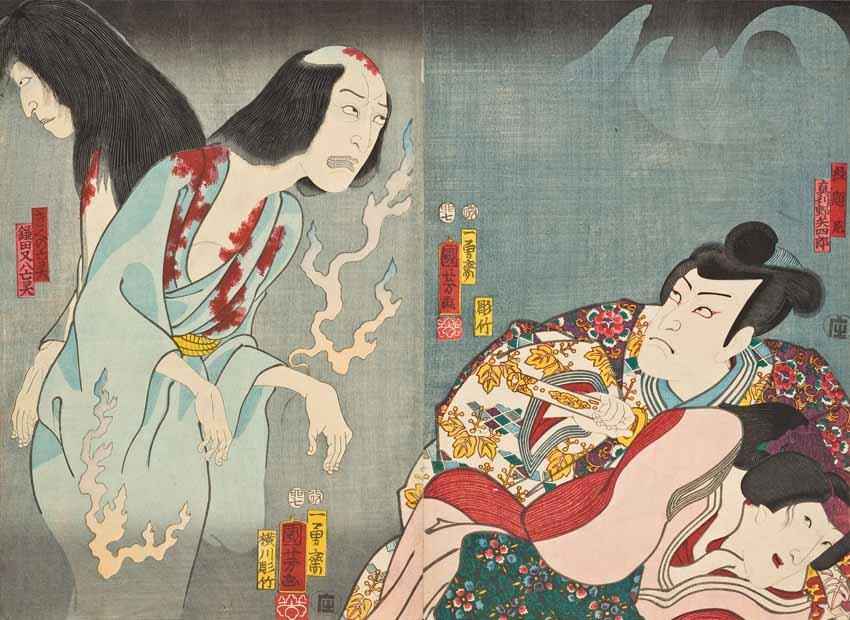Kabuki theatre was one of the most dynamic art forms to emerge from Japan’s ‘floating world’, the extraordinary pleasure districts that thrived in major Japanese cities during the 18th and 19th centuries. With its dramatic storylines, lavish costumes and celebrity actors, kabuki was the ideal subject for Japanese print designers. This exhibition, at the Peabody Essex, explores the world of Japanese kabuki theatre prints.
Stage Idols, Japanese Kabuki Theatre features a selection of kabuki theatre prints from Peabody Essex Museum’s (PEM) collection, many of which are on view for the first time. The exhibition features a rotating selection of over 40, 19th-century prints, including works by print designer Utagawa Kunisada (1786-1864), as well as rare kabuki-related objects, such as costumes, photographs and signboards.
Before Kabuki
Before kabuki there were three principal forms of theatre in Japan: the courtly bugaku dances, which, of course, were seen by very few and largely unknown to the general population; Noh, which was founded and perfected during the 14th century by Kanami and Zeami and then adopted by the ningyo joruri puppet theatre, which was patronised by the country folk and urban inhabitants and which developed into the bunraku puppet theatre we know today.
The first recorded performance of kabuki occurred in 1603, given by a group of female entertainers. It is highly probably that dancing troupes were in operation before this date, and the 1604 performances featured a miko, a ‘shrine maiden’, who may have come from a shamanist background. All we know of her is that she was called Okuni, and is said to have come from the great shrine of Izumo.
She and her troupe gave their performances on the dried-up Kamogawa riverbed in Kyoto, on almost the exact spot of the present-day Minami-za theatre. Shamanist or not, it seems clear that Okuni was also concerned with the pleasures of this world, and it is generally accepted that she and her company were involved in prostitution. If we believe the illustrations depicting Okuni’s kabuki – all of which were produced well after her period of activity – her theatre seems to have been rather revue-like, with the women dancing in a circle.
The dances appear to have been folk or quasi-religious, similar to the bon odori still performed all over Japan during the summer festival of the dead. Okuni’s theatre was extremely popular and was described as kabuku – an archaic term, unfamiliar to modern Japanese, meaning literally ‘tilted’, but implying that which is strange or outlandish, and perhaps somewhat risqué.
Shogunate Banned Women from the Stage
In 1629, however, the shogunate banned women from the stage. The reason for this is generally given as immorality – the prostitution having become more unacceptable. It seems, however, more likely this was simply a convenient excuse, and that the real reason behind the ban was the perceived threat the reputation of actresses presented to public order, on account of their popularity not simply with the commoners – who made up the majority of the audience – but also with the samurai class which, the government through, should be above such vulgar public display.
Wakashu Kabuki
Kabuki continued, however, performed by young boys who had yet to reach maturity and shave their heads in the universal samurai hairstyle of the day This become the so-called wakashu kabuki ‘young boy kabuki’, and in 1652, by order of the shogunate, the boys suffered the same fate as the women ad for exactly the same reasons. Surprisingly, kabuki performances were allowed to continue provided the actors were mature males – with shaven heads. This became known as yaro kabuki and, although the term is no longer used, developed into the kabuki we know today and is also represented in kabuki theatre prints.
The Actors, The Plays, and The Theatre
This exhibition on kabuki theatre prints is organised into three thematic sections: The Actors, The Plays and The Theatre. The Actors explores the multiple roles played by kabuki actors in society – as thespians, celebrity icons, and interpreters of theatrical tradition. A portrait by Utagawa Kunisada depicts the actor Ichikawa Danjuro VIII portraying Sukeroku, the title role from the play of the same name.
The actor’s name and role are stated in a large vertical cartouche on the upper left side of his face in kabuki theatre prints.. Presented in the okubi, or large head format, Kunisada’s attention to detail can be seen in the exquisite presentation of facial details, hairlines and intricate kimono patterns. Danjuro VIII was a member of the Danjuro lineage of actors, established in the 17th century and continuing to this day. The aragoto, or rough-style, of acting is a noted feature of the Danjuro family.
Selection of Scenes Portrayed in Kabuki Theatre Prints
The Plays presents a selection of compelling scenes from kabuki theatre, including a film excerpt from a contemporary play. Many of the prints in this section are remarkably preserved in their original album form. A work by Utagawa Kuniyoshi (1797-1861) features a dramatic moment from the play Matsutaka Temari Fuijitsuroku. In this print, two ghosts loom eerily above the play’s human protagonists, trembling in fear and defiance.
The male ghost’s dishevelled hair indicates his engagement in a conflict, causing his topknot to come undone. Skilfully printed in silhouette in the background is the Japanese character kokoro, or ‘heart’. According to Japanese folklore, crimes of passion or the heart result in an unsatisfactory death, preventing the soul from transitioning into the next world.
In The Theatre section of kabuki theatre prints, the ambience of the kabuki theatre is recreated with period photographs and promotional plaques and signboards. Hand-coloured glass lantern slides capture the life of the bustling theatre districts, allowing a glimpse of Japan as it existed over 100 years ago.
Peabody Essex Museum Stage Idols opens at Peabody Essex Museum, Salem, Massachusetts on 2 February and runs until 25 January 2009, www.pem.org.


